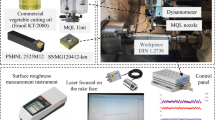Abstract
The machining of complex surfaces such as those present in rotors, impeller blades, thin-walled parts among other engineering components has been commonly carried out in multi-axis CNC machines programmed by CAD/CAM software. Even with a significant aid of the CAD/CAM systems, the users are responsible for defining an optimal set of cutting parameters, relying on their practical knowledge. This task gets harder when thin-walled parts have to be milled, because besides the problems caused by the limit of rigidity of the cutting tool, there is also the limit of rigidity of the thin-walled parts. Few works can be found on current literature concerning this issue. Then, the current work aims to analyse the influences of the cutting parameters: feed per tooth (fz); radial depth of cut (ae); and cutting direction (up and down milling), on the form errors and surface roughness of thin-walled parts manufactured by 4-axis milling using AISI H13 steel. The results show that the cutting direction (up/down milling) was the major variable to affect the form errors. Down milling left more than 0.2 mm of material on the machined part. On the opposite, up milling removes up to 0.2 mm more material than it should be. ANOVA shows that the influence of the fz on the form error is slightly higher than ae influence. In extreme cases, it can be about 1.5 times more influent than ae. Down milling and the highest values of ae and fz tested proved to be a good set of cutting conditions for milling free-form thin-walled parts, because with these conditions a good surface roughness, a positive form error and higher productivity were obtained.









Similar content being viewed by others
References
Souza AF, Coelho RT, Rodrigues AR (2010) Manufacturing complex geometries using high speed cutting technology, 1st edn. VDM Verlag, Saarbrücken
Soori M, Arezoo B, Habibi M (2014) Virtual machining considering dimensional, geometrical and tool deflection errors in three-axis CNC milling machines. J Manuf Syst 33:498–507
Ferreira AM (2013) Evaluating the form errors in free form milling. Master of Science thesis, Instituto Superior Tupy, Joinville, Brazil
Lacalle LLN, Lamikiz A, Sánchez JA, Salgado MA (2007) Toolpath selection based on the minimum deflection cutting forces in the programming of complex surfaces milling. Int J Mach Tools Manuf 47:388–400
Rao VS, Rao PVM (2006) Tool deflection compensation in peripheral milling of curved geometries. Int J Mach Tools Manuf 46:2036–2043
Desai KA, Rao PVM (2012) On cutter deflection surface errors in peripheral milling. Int J Mater Process Technol 212(11):2443–2454
Ryu SH, Chub CN (2005) The form error reduction in side wall machining using successive down and up milling. Int J Mach Tools Manuf 45:1523–1530
Costes JP, Moreau V (2011) Surface roughness prediction in milling based on tool displacements. J Manuf Process 13:133–140
Ratchev S, Liu S, Becker AA (2005) Error compensation strategy in milling flexible thin-wall parts. J Mater Process Technol 162–163:673–681
Benardos PG, Vosniakos GC (2003) Predicting surface roughness in machining: a review. Int J Mach Tools Manuf 43:833–844
Souza AF, Berkenbrock E, Diniz AE, Rodrigues AR (2014) Influences of the tool path strategy on the machining force when milling free-form geometries with a ball-end cutting tool. J Braz Soc Mech Sci Eng. https://doi.org/10.1007/s40430-014-0200-9
Szymon S, Mrozek K (2017) Mechanical and technological aspects of micro ball end milling with various tool inclinations. Int J Mech Sci 134:424–435
Vopát T, Peterka J, Šimna V, Kuruc M (2015) The influence of different types of copy milling on the surface roughness and tool life of end mills. Proc Eng. https://doi.org/10.1016/j.proeng.2015.01.443
Michalik P, Zajac J, Hatala M, Mital D, Fecova V (2014) Monitoring surface roughness of thin-walled components from steel C45 machining down and up milling. Measurement 58:416–428. https://doi.org/10.1016/j.measurement.2014.09.008
Zhanga Z, Lia H, Liua X, Zhangb W, Meng G (2018) Chatter mitigation for the milling of thin-walled workpiece. Int J Mech Sci. https://doi.org/10.1016/j.ijmecsci.2018.02.014
Seguy S, Dessein G, Arnaud L (2008) Surface roughness variation of thin wall milling, related to modal interactions. Int J Mach Tools Manuf 48:261–274
Popma M (2010) Computer aided process planning for high-speed milling of thin-walled parts: strategy-based support. Thesis, Department of Engineering Technology, University of Twente, Enschede, NL, Netherlands, 177 p
Acknowledgements
The authors thank CNPq, FAPESC under Project No 04/2011 and the enterprises Villares Metals; VERO-SESCOI and CGTech.
Author information
Authors and Affiliations
Corresponding author
Additional information
Technical Editor: Márcio Bacci da Silva.
Rights and permissions
About this article
Cite this article
de Oliveira, E.L., de Souza, A.F. & Diniz, A.E. Evaluating the influences of the cutting parameters on the surface roughness and form errors in 4-axis milling of thin-walled free-form parts of AISI H13 steel. J Braz. Soc. Mech. Sci. Eng. 40, 334 (2018). https://doi.org/10.1007/s40430-018-1250-1
Received:
Accepted:
Published:
DOI: https://doi.org/10.1007/s40430-018-1250-1




